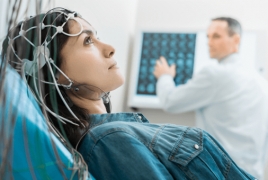Electrical brain stimulation "improves depression symptoms" March 12, 2019 - 16:32 AMT PanARMENIAN.Net - With a weak alternating electrical current sent through electrodes attached to the scalp, UNC School of Medicine researchers successfully targeted a naturally occurring electrical pattern in a specific part of the brain and markedly improved depression symptoms in about 70 percent of participants in a clinical study. The research, published in Translational Psychiatry, lays the groundwork for larger research studies to use a specific kind of electrical brain stimulation called transcranial alternating current stimulation (tACS) to treat people diagnosed with major depression. "We conducted a small study of 32 people because this sort of approach had never been done before," said senior author Flavio Frohlich, PhD, associate professor of psychiatry and director of the Carolina Center for Neurostimulation. "Now that we've documented how this kind of tACS can reduce depression symptoms, we can fine tune our approach to help many people in a relatively inexpensive, noninvasive way." Frohlich, who joined the UNC School of Medicine in 2011, is a leading pioneer in this field who also published the first clinical trials of tACS in schizophrenia and chronic pain. His tACS approach is unlike the more common brain stimulation technique called transcranial direct stimulation (tDCS), which sends a steady stream of weak electricity through electrodes attached to various parts of the brain. That approach has had mixed results in treating various conditions, including depression. Frohlich's tACS paradigm is newer and has not been investigated as thoroughly as tDCS. Frohlich's approach focuses on each individual's specific alpha oscillations, which appear as waves between 8 and 12 Hertz on an electroencephalogram (EEG). The waves in this range rise in predominance when we close our eyes and daydream, meditate, or conjure ideas -- essentially when our brains shut out sensory stimuli, such as what we see, feel, and hear. Previous research showed that people with depression featured imbalanced alpha oscillations; the waves were overactive in the left frontal cortex. Frohlich thought his team could target these oscillations to bring them back in synch with the alpha oscillations in the right frontal cortex. And if Frohlich's team could achieve that, then maybe depression symptoms would be decreased. His lab recruited 32 people diagnosed with depression and surveyed each participant before the study, according to the Montgomery-Åsberg Depression Rating Scale (MADRS), a standard measure of depression. The participants were then separated into three groups. One group received the sham placebo stimulation -- a brief electrical stimulus to mimic the sensation at the beginning of a tACS session. A control group received a 40-Hertz tACS intervention, well outside the range that the researchers thought would affect alpha oscillations. A third group received the treatment intervention -- a 10-Hertz tACS electrical current that targeted each individual's naturally occurring alpha waves. Each person underwent their invention for 40 minutes on five consecutive days. None of the participants knew which group they were in, and neither did the researchers, making this a randomized double-blinded clinical study -- the gold standard in biomedical research. Each participant took the MADRS immediately following the five-day regimen, at two weeks, and again at four weeks. Authorities said a total of 192 Azerbaijani troops were killed and 511 were wounded during Azerbaijan’s offensive. In 2023, the Azerbaijani government will increase the country’s defense budget by more than 1.1 billion manats ($650 million). The bill, published on Monday, is designed to "eliminate the shortcomings of an unreasonably broad interpretation of the key concept of "compatriot". The earthquake caused a temporary blackout, damaged many buildings and closed a number of rural roads. Partner news |